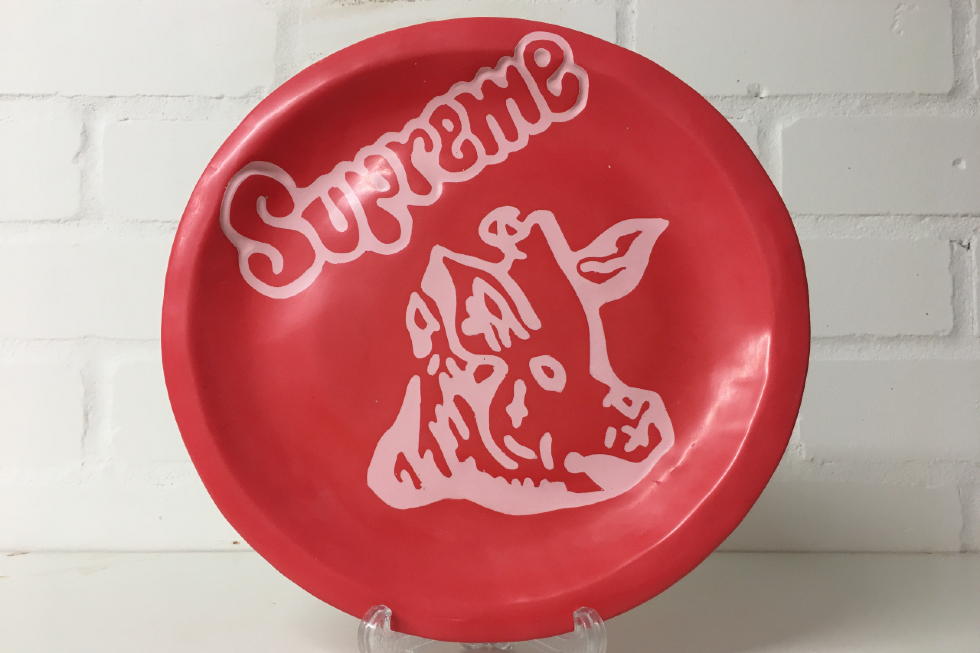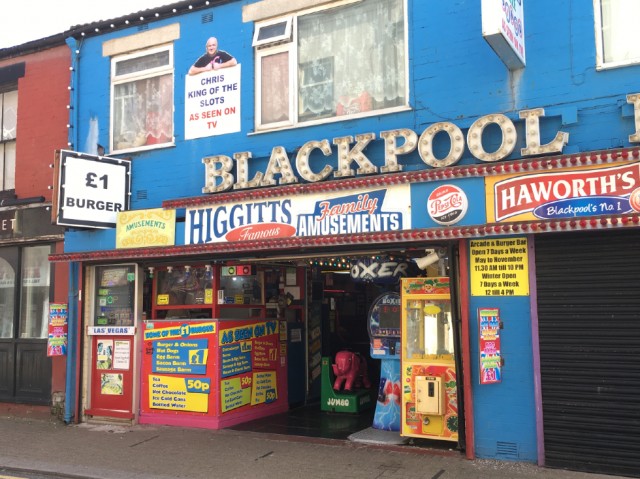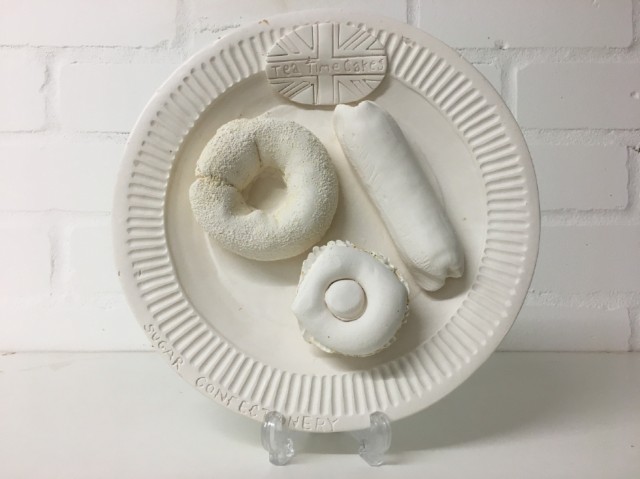“Objects can be used to explore contrasts or boundaries”
A Conversation With Artist Charlotte Dawson

“It was good to get the two sides of Blackpool.” Mike Pinnington speaks to artist Charlotte Dawson about her Work/Leisure residency with the seaside town-based Abingdon Studios…
What really strikes me about Charlotte Dawson’s work is how tactile looking it is – you want to almost reach into the screen and grab those plates of food. You could, in fact, eat your dinner off them. Their familiarity – these everyday objects are adorned with everything from all day breakfasts to cakes – produces a refreshing immediacy that’s often lacking in the contemporary art world. And yet, there is clearly more to the earthenware pieces than this (more of which in a bit). The plates are being made for Dawson’s residency with Abingdon Studios’ Work/Leisure programme. The artist (who is based at Sheffield’s S1 Artspace) visited Blackpool in-between lockdowns, “as soon as I found out I’d got it [the residency]”.
This was in the summer she tells me over the phone. “I thought: ‘I want to go to begin thinking now, to start the process.’” It must have been interesting, I venture, a trip to the seaside when, although we were being told that staycations were the thing to do, circumstances were definitely not the norm. “It was good,” she replies, “because it was sort of open – not full of people, but quite a lot of people.” With the initial prep and road-testing of some ideas well underway, she then paid another visit at the beginning of October, “just after most of Lancashire had gone in [to lockdown].”
Unlike on the previous trip, she says, “It was raining and it was a Tuesday, so it was a less touristy side and more of, like, ‘ok, this is what it’s like to live here.’” With the added urgency of a likely second lockdown, this second visit proved productive. “When I went again, it was like, ‘these were the things I want to see.’” And, she tells me, she “did a lot of purchasing… Sort of more gathering things.” Choosing to explore off the beaten track this time meant getting a broader, more balanced picture of Blackpool than many day-trippers or weekenders ordinarily would. “Abingdon’s above an indoor market, so I bought a few things in there, but I mainly took a lot of pictures, and then I walked through the town and along the front. A few streets back you get a lot of cafés, so I took a lot of photographs of outdoor advertisements. I was interested in that element of the very real pictures of plates of food compared with sugar versions that you can buy at the front.”

All of this research was added into the mix with planning she had undertaken prior to her visits: “some of the works I’d got clear in my proposal.” It meant that she had “about four designs” to begin working on, with others taking “influence directly from Blackpool.” In addition, the two trips at very different times of year meant that she got the “two sides [of Blackpool] on two separate days.” They made for a good contrast, juxtaposing summer’s kiss-me-quick vibes with the blustery, quiet off-season of the historic seaside town. Such contrasts, it seems, readily make their way into Dawson’s work. “[It] changes; the objects that I’m depicting can be industrial, or household. I have no recognisable thing, or a brand. But in all the pieces I’ve made there’s that play between space, or two elements in contrast that has existed throughout my work.”
Dawson has also spoken about her sculpture – and objects in general – as ‘methods of communication’. I ask her what she’d like her work on this residency to communicate. “I was interested in the ways plates can be used as decoration: heirlooms, prizes. How objects can have so many meanings,” she begins. Then: “There is that difficulty when people ask: ‘what do you make?’ Or ‘why do you make it?’” They can be thought of, she explains, as “physical still-lifes almost.” How are they made, I ask. “The plates are in Jesmonite. Their forms are made in clay, then I make a mould of that in silicon and cast in Jesmonite. With the moulds I can produce multiples. I also don’t have any knowledge of ceramics or access to a kiln – so it’s weird to be making plates that aren’t ceramics, but their form looks like they are.”

Expanding on her relationship to sculpture and its potential for combining functionality with symbolism, she says: “I like that objects exist in everyday life but can be used as a way to explore contrasts or boundaries – between space or between purpose”, she says, pointing out that “Work/Leisure has that contrast, that push/pull between ways of viewing something.” Going further, she explains that “In one object you can have both work and leisure. The plate symbolizes that element of the service industry – that one symbol in the one act is both labour for somebody and reward and leisure for another person, and that’s sort of what I’m aiming to explore.” While it’s not just Blackpool where you’ll find these dualities, “there’s a heightened element to those objects” there, she says.
During lockdown, Dawson has been on furlough from her other job in a café, and the residency was, in the first instance, an opportunity to make work that came with funding and practical gallery support. But it has also allowed her to address very current – and very real – concerns about food poverty. “We were having a discussion on Zoom, where I was talking [with Garth Gratrix, co-director of Abingdon Studios] through the pieces I was making. Naturally, conversations were coming up around elements of food waste and how that would be pertinent in an area like Blackpool and the whole context of this year and the struggles people are having.” As such, they decided to run a Crowdfunder addressing the situation, with edition prints as rewards. “So many people are hungry or on diminished wages; people have lost businesses.” Money raised will go to local food banks. Art in action.
What about a physical incarnation of the work, will we get to see it in whatever post-lockdown world emerges in 2021? “If we can, then that’s what we’re planning to do. In my head that’s what I’m working towards. I’ve discussed it with Garth and it’s something we want to realise together – show the work. It would be nice to fill a space and have that extra element. We’re hoping to install it to formalise the piece in the space and join all those elements up together.”
Mike Pinnington
Images courtesy Charlotte Dawson
Support Artists Say No To Empty Plates
Abingdon Studios founded the Work/Leisure residency programme in 2016 to support artists with time, space and money to think through, test and or complete existing ideas in a way that firstly felt most useful to their development and secondly as a means for Abingdon to continue to understand how artists are working and how this might relate or react to a place unique as Blackpool.
Abingdon Studios, as part of its 2020 Emergency Response Fund packages of support, commissioned The Double Negative to highlight the work of the studio’s current Work/Leisure residency artists. With thanks to Arts Council England and guest selectors, curator Paulette Terry Brien, and artists Laura Jamieson and Emily Speed.





